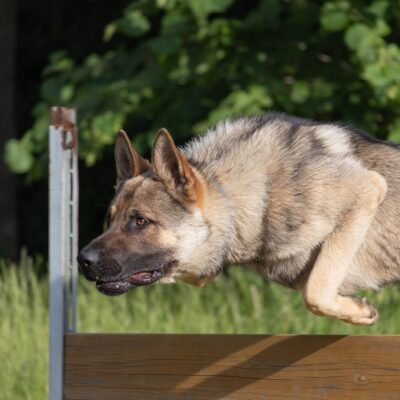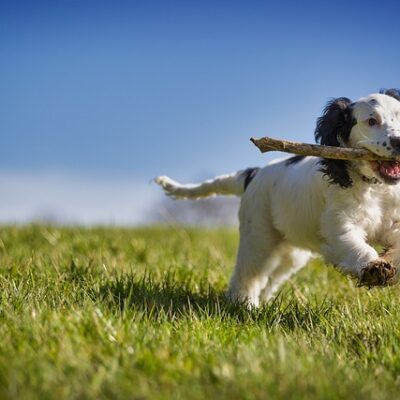Toys are expensive, and if your dogs are anything like mine, they don’t last long. We always have a toy being stitched back together.
These toys are all easy to make and include things that are usually around the house.
Dogs also love them more than store-bought toys as they are made with old clothes which smell like you.
These three toys are perfect for all dogs, whether you have a dog who loves to chew, chase a ball around, or play tug-of-war.
New toys are great for enriching your dogs’ life. New smells and games are great for stimulation. There are many benefits of enrichment for dogs. Including:
- Tires your dog out – A tired dog tends to be easier to train and better behaved.
- Increase brain capacity – Playing games keeps your dog’s brain sharp.
- Rewarding for your dog – Being rewarded with treats or toys is great for dogs, it keeps them happy and mentally healthy.
- Lowers stress and anxiety – Increasing physical and mental exercise is excellent for decreasing mental stress for your dog.
- Increases the bond between you and your dog – Introducing new and fun games is exciting for your dog, by helping and playing these games, you will improve and build your relationship.
Physical exercise is incredibly important. But mental stimulation is arguably just as important, if not more so. It is thought that 1 hour of physical exercise is equivalent to 10 minutes of mental training. It is a great way to tire out your furry friend and leave them feeling fulfilled and happy.
There are plenty of ways to mentally challenge your pooch, from a sniffy walk in a new park to some of the more fancy toys explicitly designed for brain games.
Busy? Get Your Hands Paws On The Answers Quickly…
- How To Make 3 Easy Homemade Dog Toys
- Quick Video On How To Make 3 Easy Homemade Dog Toys
- Printable PDF Guide
HOW TO MAKE 3 EASY HOMEMADE DOG TOYS
1. Tennis Ball Tug Toy
Equipment:
- A tennis ball
- An old t-shirt
- Scissors
Directions:
| 1. Cut the t-shirt into 3 strips. | ||
| 2. Tie the 3 strips into a knot at one end. | ||
| 3. Plait the 3 strips from the knot to the middle. | ||
| 4. Make 2 holes in the tennis ball opposite each other. | ||
| 5. Thread 2 of the strips through the tennis ball holes. You may need to use a skewer to push the strips through. | ||
| 6. Join the remaining strip with the other 2, covering half of the tennis ball. | ||
| 7. Continue to plait and tie in a knot to secure. | ||
| 8. Play! | ||
2. Sock and Ball Toy
Equipment:
- 2 tennis balls
- An old sock
Directions:
| 1. Place the first tennis ball into the sock. | ||
| 2. Tie a knot next to the tennis ball. | ||
| 3. Add the other tennis ball. | ||
| 4. Tie another knot at the top of the sock. | ||
| 5. Play! | ||
3. Octopus Tug Toy
Equipment:
- A tennis ball
- An old t-shirt
- Scissors
Directions:
| 1. Cut the t-shirt into 3 long strips. | ||
| 2. Place the strips in a star position with the middle of the strips overlapping. | ||
| 3. Place the tennis ball on top of the middle of the strips. | ||
| 4. Take each end of one strip, tie a knot over the top of the tennis ball, and secure it. Repeat with the other 2 strips to cover the ball. This will create 6 strips hanging from the ball. | ||
| 5. Divide the 6 strips into 2 sections of 3 and make 2 plaits. Tie the ends in a knot to secure. | ||
| 9. Play! | ||
QUICK VIDEO ON HOW TO MAKE 3 EASY HOMEMADE DOG TOYS
Disclaimer: Always supervise your dog when using enrichment toys. Make sure the ice is defrosted slightly so their tongue, nose, and paws do not stick. If your dog is a vicious chewer, be mindful that ice can damage their teeth. Ice should not be given to a dog on a hot day to cool them down as it can have the opposite effect.
Not ready to make the snuffle mat? Looking to share the instructions with friends?
Print the guide here and save and share!
Looking for more pawsome posts? Check these out…
Can Dogs Eat Lettuce?
How To Make A Snuffle Mat
When Do Puppies Lose Their Teeth?
Can Dogs Eat Broccoli?
Can Dogs Eat Watermelon?
Disclaimer: Each dog is different, and every circumstance is different. All efforts have been made to provide accurate information. However, it is not provided by a qualified Veterinarian, Veterinarian Surgeon, or Behaviorist. The information provided is purely educational. The information should not be used as an alternative or substitute for medical care. If you have any health or medical concerns, contact a qualified Veterinary Surgeon or Veterinarian immediately.










No Comment! Be the first one.